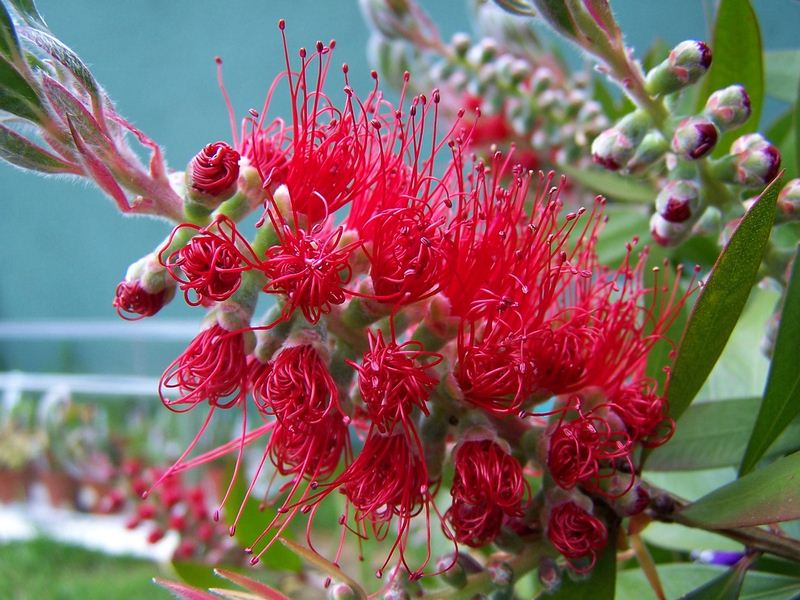Many Australian natives will grow in other countries where the climate is mild. Bottle brushes will tolerate light frosts and dry areas.
Many bottle brushes – aka Callistemons – will also tolerate wet feet, making them a versatile and easy plant to grow. They are attractive and the flowers come in various colours, with a flush in the spring or summer and additional flowers throughout the year.

Read Also:
Bottle brushes are so-called because their flower resembles a bottle brush – but only in form. The colours are magnificent; bright red being the most popular. Cream, yellow, purple and pink, green, mauve and white is also to be found on different species. These tight clusters of filaments are covered with pollen, while nectar is formed within the flower.
Once the flower has finished the seeds form – a hard, woody cylinder of fruiting capsules. Eventually, these will open to release the many very fine seeds they contain. To save seed they should be picked when ripe and placed into a paper bag. After they open, the seed can be planted.
There are many varieties of bottle brush and so many different heights. Some grow as small shrubs to about half a meter high, while others are more like small trees up to 4 meters. There are also taller shrubs and shorter trees. One of the best-known bottle brushes is Callistemon Viminalis or Weeping Bottle Brush. It has a profusion of bright scarlet brushes that hang down in an attractive fashion. The tree usually grows from 5-7 meters tall. It is frost tender, especially while young.
A slightly hardier version is Callistemon Citrinus, the Crimson Bottlebrush. It is similar to Viminalis only the branches do not have that weeping habit. It grows to 4 meters and does well in damp conditions. That said, it will also tolerate dryer feet and light frosts.
Callistemons do like to be fertilised, but the fertiliser used should be low in phosphorus. It should be applied in both spring and autumn. They will grow in almost any soil, but not if it is alkaline. They will appreciate mulch placed over the roots but should be grown in a sunny position.
Pruning should be done once a year just after the first flush of flowers has finished. Only cut off the flower spikes to just behind the flower. Tip pruning can be done as new growth appears. However, this should not be left until too late, as next year’s flowers form on the end of this year’s growth after it has hardened off.
The bottle brush should never be pruned deep within the tree where there is no foliage. Only if the tree is old and/or misshapen should this kind of pruning be done? A very old tree can be completely rejuvenated by cutting off all the branches as this mimics what would happen in a bushfire, nature’s way of rejuvenating plants in the wild – at least in Australia.
As mentioned above, the seed cylinders can be placed in a brown paper bag to save the fine seed. This seed will germinate in a seed-raising mixture that drains freely. But if preserving the cultivar is the aim, then cuttings should be taken as the seeds do not grow true to the parent. Cuttings of the Callistemon should be taken from semi-mature wood.
As with many plants, different species grow better in different climates. But don’t forget that many gardens have a mini-climate that is slightly different from those surrounding it. Thus a warmer spot can be created by a wall that reflects and retains warmth and surrounding bushes that protect from the worst of the frost.
The Prickly Bottlebrush – Callistemon brachyandrus – grows really well in hot, dry areas. As its name suggests, this bottle brush has prickly foliage, the flowers are red and the tips of the filaments are covered by yellow pollen, giving it a distinctive glow.
For frost free and tropical areas only, the Kingaroy Bottle Brush – Callistemon formosus is the one to plant. Its attractive flowers are a lemon on weeping branches and the tree grows to 3 meters.
If lemon flowers are favoured then the Lemon Bottle Brush – Callistemon pallidus is one tough cookie that will tolerate frosts, though it needs full sun. Another favourite for those colder areas is the Alpine Bottlebrush – Callistemon pityoides.
There are much more too numerous to mention, but unfortunately for those people who have snowy winters, none of the Callistemons will survive such a climate. However, Callistemon subulatus will tolerate wetter conditions than most of the others. It has red flowers and at 1-3 meters is one of the smaller cultivars.
So why not grow a plant that is just that little bit unusual and extremely attractive to both birds and humans? The Australian Bottle Brush is worth a place in the garden.